A man must own his tools, or they’ll own him. The two enemies of firearms are rust and politicians, and we’ve had enough of gun politics lately, so we’ll deal with preventing rust. The way to keep rust and other bad situations from befouling your guns is to keep them clean, dry, and lubricated. Today we’ll talk about basic rifle cleaning practices with a special guest: you love it, they hate it, give it up for the AR-15.
Safe Rifle
The first and foremost thing about firearms is always safety, and the first rule is always point the muzzle in a safe direction. I never look down the barrel of a gun unless it’s disassembled or I am physically holding the action open, so there will be no muzzle shots today.
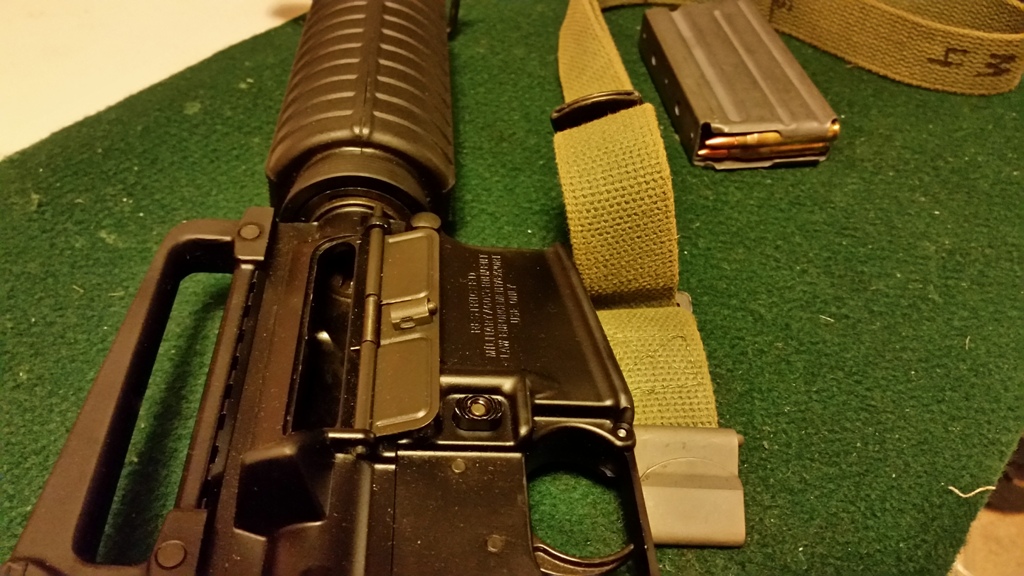
The second rule being always treating firearms like they are loaded, we will unload the rifle from the condition in the title picture and take off the sling, being the only accessory.
Disassembly
The most important thing to clean in a rifle is the rifling in the barrel and the firing chamber, including the bolt face. For semi-automatic rifles, especially direct impingement rifles like a classic AR, you need to get everywhere combustion gas goes to clean that up as well. Equally, if not more important than being clean is being lubricated and free of moisture, so you need to oil and grease there, too.
Firstly, you want to get the bolt out of the rifle so you can have access to it, the receiver, and the breech end of the barrel. It’s really hard to clean a rifle well without getting the bolt out. For an AR, you pull the two captive disassembly pins, drop out the lower receiver, and pull the bolt out with the charging handle.
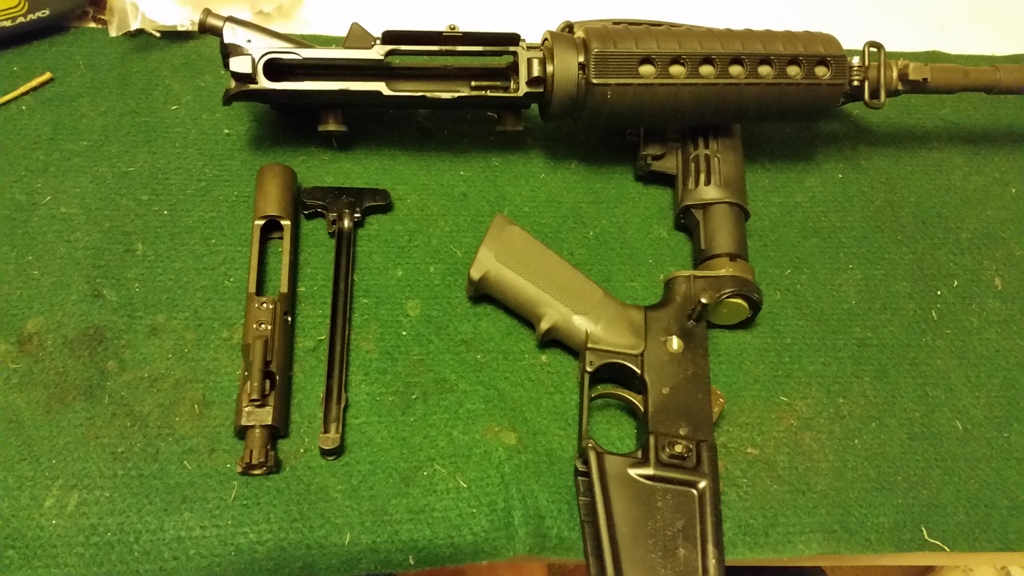
I’ll have a more detailed article on the AR and its features and component parts soon, but let’s focus on the general technique here.
Cleaning
You’re going to need three liquids to clean a gun, and some cleaning utensils. You can get a good set of brushes and rods and such going for under a hundred bucks that will last you forever, and the basics will run you twenty or so total.
First you’ll need solvent to dissolve the grime. Some people like harsh stuff, I like a milder solvent like Hoppe’s, and I do have their copper solvent if needed. Solvent takes some time on bad grime and fouling, sometimes you may need to let it sit. You’ll need oil for lubrication and rust prevention, and grease for lube on high friction points that you want to stay lubed (oil travels, grease doesn’t.) I like a higher viscosity oil, a lot of guys will swear by better car oils, and some use actual axle grease for grease. I like the oil in the picture, and I like a monolithic grease like RIG, as opposed to a suspended grease like white lithium.
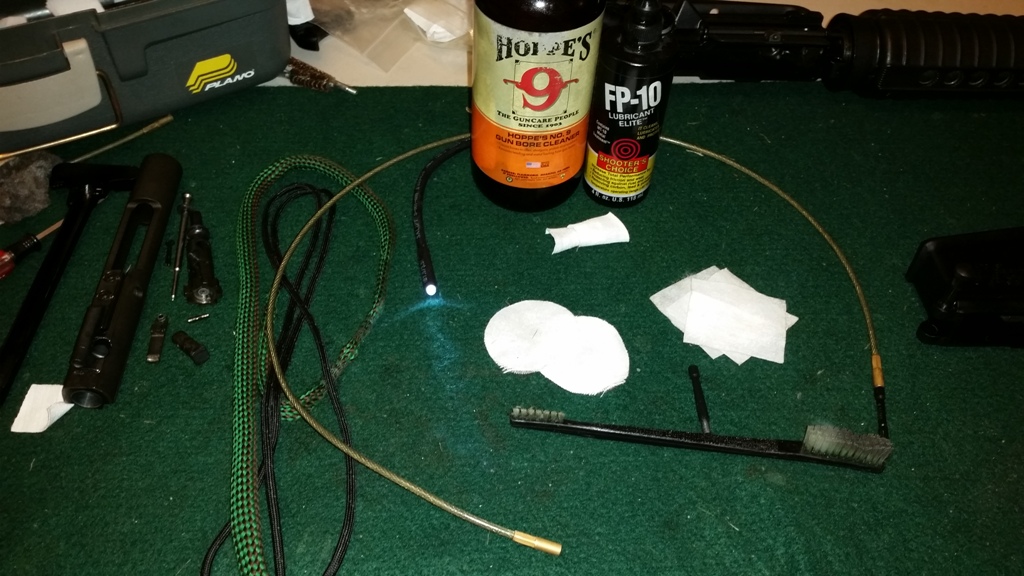
Nylon toothbrush, otis cable with slotted tip, a jag, some patches, a Hoppe’s Bore Snake in .22, a bore light, Hoppe’s 9 solvent, and Shooter’s Choice FP-10 oil.
A variety of patches helps, a nylon toothbrush helps as well. Get a three pack of nylon, copper, and steel toothbrushes and toss the steel one. Copper or brass brushes can be used safely on guns, steel is too hard and only for extreme problems. A cheap ass bore light is nice, too.
You have some choices when it comes to rods. The best rods are one piece and either not steel at all, or coated steel. You are trying to avoid gouging your barrel bore here. I like the OTIS cable seen in the pictures as well, as it allows you to pull a brush through, then thread it in again without taking the brush off.
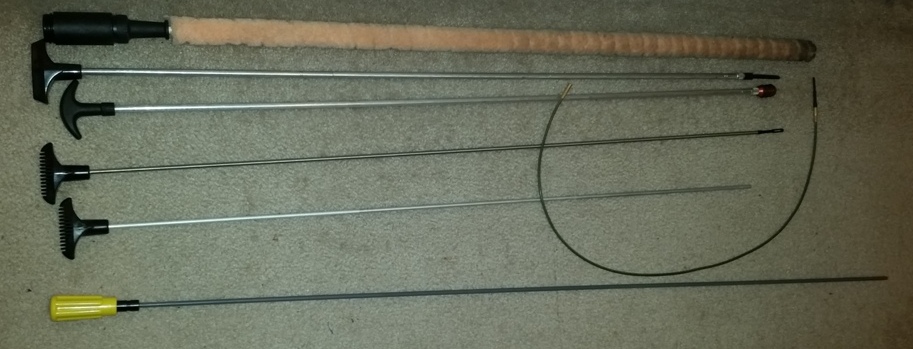
Top down: TICO Tool (for shotguns), 3 piece shotgun rod with shotgun slotted tip, 3 piece shotgun rod with O-ringed 12 gauge jag, 1 piece steel rifle rod, 3 piece steel rifle rod, and lastly a carbon fiber rifle rod. OTIS cable to the side.
Tips for cleaning have different purposes. The slotted tip is for dragging a soaked (either with solvent or oil) patch through the bore. The jag is for pushing a patch through the bore hard up against it to either sop up the extra solvent and grime, or really work some bore polish in there.

Bore brush to left, jag in middle, slotted tip to right with solvent soaked patch.
The brush is for PULLING through ALWAYS starting from the BREECH end and out the MUZZLE end to dislodge heavy fouling. Never push a brush, and never put it in at the muzzle, you can damage the crown that way. if you have a rifle that you cannot run a rod from the breech end, use a muzzle crown protector, ease the bare rod down the bore, connect the brush inside the receiver and pull it out.
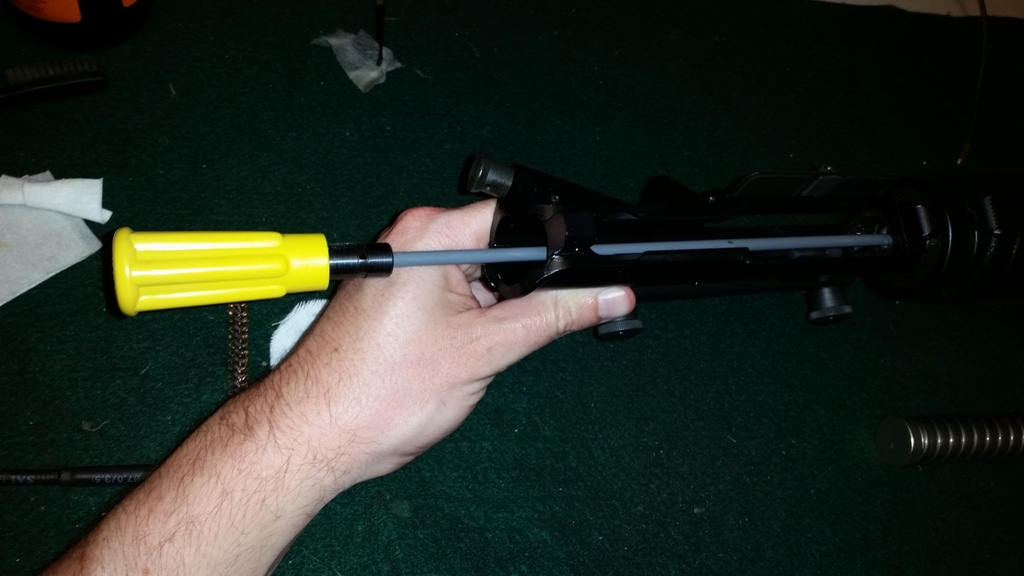
Always rod a gun from the breech end whenever possible.
Start by running a soaked solvent patch down the barrel and then let it sit while you clean other things. If you happen to be some crazy Russian ammo enthusiast and like shooting cheap shit down your rifle, then you need to deal with the problem of corrosive primers. I limit my corrosive ammo to my cheap and inaccurate Chinese SKS, and my even cheaper and less accurate Mosin Nagant. Get some ammonia based window cleaner like Windex, put the gun muzzle down, insert the nozzle in the firing chamber, and liberally hose that thing down until a whole bunch has gone out the muzzle, safely washing away the corrosive salts. Continue with the solvent patch as noted above.
Take your rifle’s action down to component parts, like the firing pin and such, and swab them clean with solvent patches. The AR is an easily stripped rifle. Be aware that some rifles are a pain in the ass, and some also loosen up the more you take them apart. Know when enough disassembly is enough, and know what level of cleaning you’re doing (storage over the winter, or will be shooting it next month) and take it to the right level.
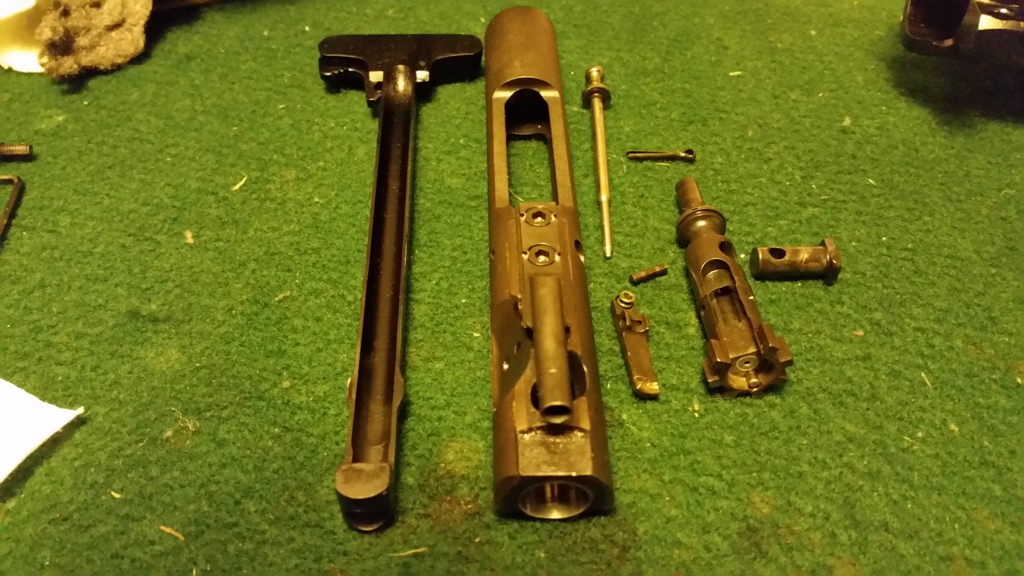
The AR bolt strips fairly easily, so I usually take mine down to this level. Other guns require acts of Congress to get this far, so act accordingly.
Once you’ve cleaned all parts of the rifle, return your attention to the barrel. It may need some brushing, so pull the copper brush through a number of times, then run another solvent patch. You will notice that most grime will go away. Once satisfied, run dry patches through it to absorb everything until they come out as clean as you care to go for, then run an oiled patch down the bore to prevent rust.
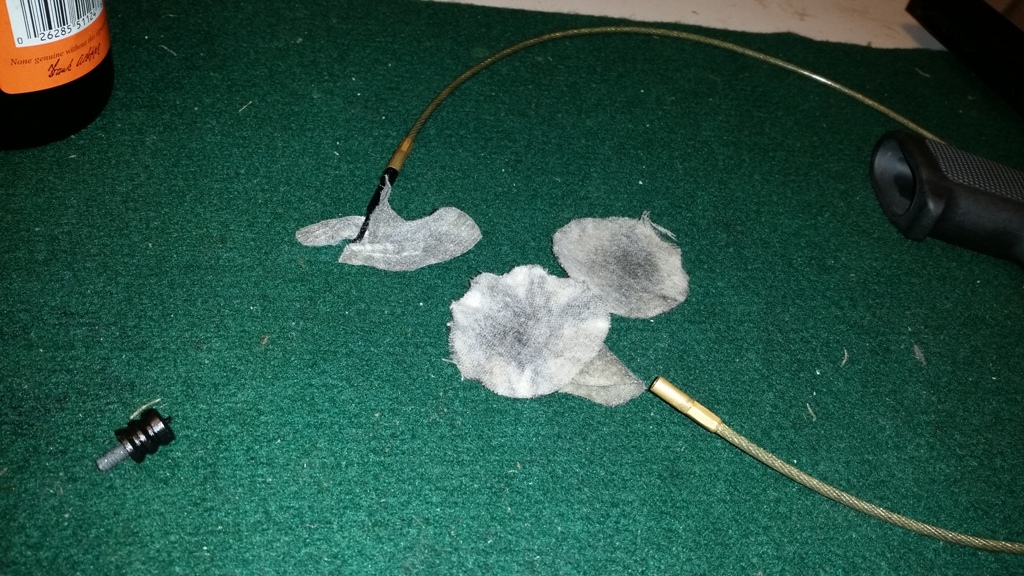
You should have a pile of dirty patches when done. Let them dry out, then toss them.
Lubrication
The amount of oil and grease you want places depends on your use of the gun, how much you like the gun, and your personal preferences. I oil the holy hell out of my safe queens, less on my carry guns, and my crap guns are lucky to get any. You don’t want to POUR oil down the bore, you just want it lubed, not dripping. Liquids in the bore actually blocking the bore will hydrolock the gun upon firing and blow it and you up.
Oil does two things, lubrication and rust prevention. Grease will also protect against rust, but is a little messier. There is also wax, like car wax, for when you want to preserve a gun and not shoot it. Oil should go everywhere there is metal for rust prevention. Friction points with moving and sliding metal should also get hit for lubrication. I like to use grease on the hardest hit points, the hammer, the bolt rails and lugs, and the magazine catches.
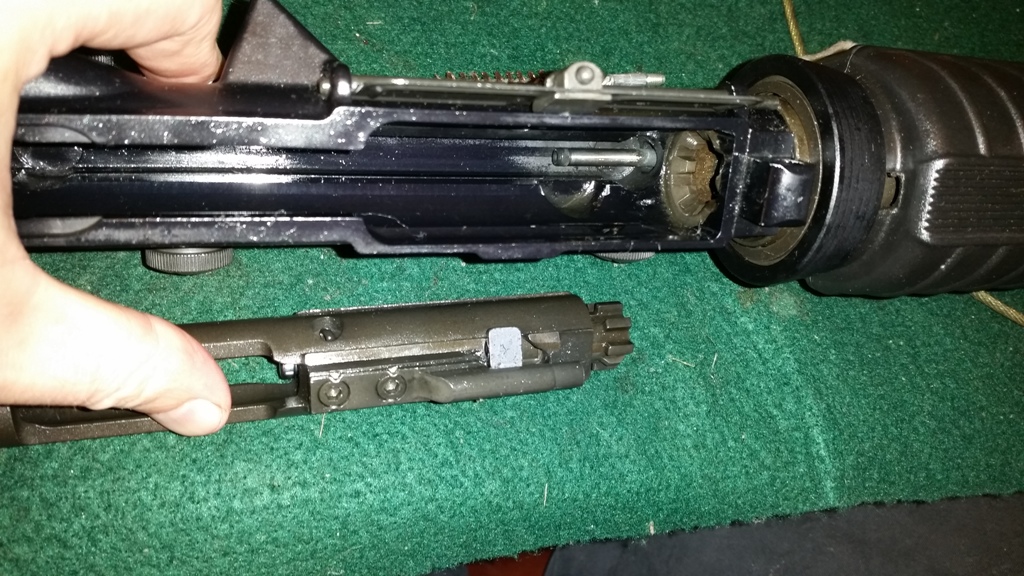
Oil on the bolt lugs and their recesses in the barrel, and on the bolt cam as well. There are two holes on the other side of the bolt for oil as well. Hit the receiver rails inside the rifle, as well as a general coat around the inside, and get under the gas tube better than I did.
After you shoot and get to know your gun, shiny wear spots will show up places, and that is where the gun will want the grease. A little dab will do.
Once you have the inside all cleaned and lubed, button the rifle up and do a function check. Make sure it dry fires, the safety works, and a mag will chamber (use an unloaded one). I like to leave all my centerfires with the hammer down to save the springs, so I’ll dry fire it and leave it uncocked.
Wipe down all outside metal surfaces to get all the fingerprints off, and put it in the case or the safe. I don’t think you should store a gun in a soft case, and a safe or cabinet is preferable to a hard case. Locking the gun up is good for safety, but, for air circulation, there’s no problem with leaning it up in the corner of the closet, either.
Conclusion
Gun care is something you should absolutely practice. It’s ok to leave a gun dirty for a while, as long as it is dry, especially if you plan to shoot it again soon. But, at some point, the gun needs to be cleaned back to its original condition, and then properly stored. Remember to check on it every few months, run a new oily patch down the barrel, and check to make sure the action is still lubed, and also do this if you’re taking it shooting and it’s been a while since its last trip. Be safe.

Cleaned and lubed.
Read More: 3 Things Cosmo Gets Wrong About Relationships With Men Who Own Guns.
Thanks. Great article. Every masculine man should have a rifle.
And a pistol and shotgun. Become proficient and take care of your gear and it will take care of you.
How about this: go sign up for the military for 8 years and they’ll pay you to learn how to shoot and clean the damn thing. I got that on a couple of guys in a bus station when I was traveling after basic. I was in class As and they commented about my uniform. I informed them that I knew a guy who would give them a set for free. It took them about a minute to figure it out.
It takes the military 8 years to teach someone to shoot and clean a gun? Think I’d have better luck learning how on YouTube.
all contracts are 8 years they’re divided up between active, reserve and inactive reserve, but they’re all 8 years. I just played the straight man for your poor joke, so you happy?
That is correct. Even if you leave active, they can still call you up !
Most of the time, that’s more trouble than its worth.
Yes. Much happier now, thanks.
In 1990, I thought they were going to call me up to fight Saddam. I had long since left the military, was overseas in Japan, had a girlfriend (now my wife). Thought I was going to have to leave it all and go home then Iraq to fight. But they did not call me. Thank goodness.
Go sign up for 8 years of the modern military, and they’ll pay you to learn to walk in high heel shoes and train you to only piss sitting down.
Have a drink, switch your dirty mind on and read the article again.
“A man must own his tools, or they’ll own him.”
“The two enemies of firearms are rust and politicians…”
“The first and foremost thing about firearms is always safety, and the first rule is always point the muzzle in a safe direction.”
“I oil the holy hell out of my safe queens, less on my carry guns, and my crap guns are lucky to get any.”
You get the idea. Yeah, I shouldn’t be so childish.
On a more serious note, I enjoyed the article a lot.
Damn, I thought my childishness was original.
Nope. Its been done unimaginable number of times.
..
You are no more clever than a bathmat.
I can live with the cleverness level of a bathmat.
“Gun care is something you should absolutely practice. It’s ok to leave a gun dirty for a while, as long as it is dry, especially if you plan to shoot it again soon. But, at some point, the gun needs to be cleaned back to its original condition, and then properly stored. Remember to check on it every few months, run a new oily patch down the barrel, and check to make sure the action is still lubed, and also do this if you’re taking it shooting and it’s been a while since its last trip. Be safe.”
Switch the word ‘gun’ with ‘cock’.
“Once you’ve cleaned all parts of the rifle, return your attention to the barrel. It may need some brushing, so pull the copper brush through a number of times, then run another solvent patch. You will notice that most grime will go away. Once satisfied, run dry patches through it to absorb everything until they come out as clean as you care to go for, then run an oiled patch down the bore to prevent rust.”
That sounds like some blowjob advice there.
But what if you “cock your gun?”
“Cock your cock.”
“Assemble my cock in two minutes!”
Bruce Jenner
Hickory dickory cock!
I currently make close to six to eight thousand bucks monthly for freelance jobs i do at home. For those of you who are willing to do basic at home work for 2-5 hrs every day from your couch at home and get decent paycheck while doing it… Try this job http://self90.com
Don’t talk to me and my son
I basically make around $6000-$8000 /every month from freelancing online. Anyone ready to complete easy freelance work for 2-5 h a day from your house and earn decent paycheck in the same time… Try this gig http://self36.com dfgds5325fds
Ha!
Well done
really? clearly you haven’t shot a gun before
Jesus, I was joking.
Most important thing is youtube. I learned how to take apart my SKS and clean it using youtube. Ditto for my mosin nagants and my Arisaka.
I admit I am too lazy to clean all my firearms after every trip to the range. But it is a useful skill.
one interesting tip a gunsmith gave me for the exterior of the gun, try using car wax on it. get a nice, shiny layer of wax layed down and you don’t have to worry about skin acids causing rust.
I’m reminded of those lazy Sunday mornings when my dad would bring out his rifles and pistols to clean ’em on the kitchen table, then we’d go target shooting, blasting apart soda bottles, cds and the occasional picture of Barney the dinosaur. Good times…
Dang, I need to get around to cleaning my revolver: the cylinder jams after firing all the rounds in it.
If you’re starting with a clean revolver, check for lead buildup on the cylinder face, then your cylinder/barrel gap and cylinder endshake. Sounds like they’re out of spec. Many manufacturers will reset these as part of a free safety inspection – but they won’t clean it for you 😉
The manufacturer was a now-defunct Netherlands company that exported revolvers from around Europe to America.
But when my father gave it to me for my birthday he gave me some cleaning supplies. Just have to set aside the time to clean it. Perhaps when I’m working on my other projects tomorrow…
Never look down a barrel of a gun. Have someone you don’t like do it for you.
I have to tell you, this is the best AR cleaning kit i’ve found – I love this kit and my buddy was so jelly when he saw how awesome this was. Super cheap on Amazon!
https://www.amazon.com/gp/product/B011X9V70I/ref=oh_aui_detailpage_o03_s00?ie=UTF8&psc=1
Ballistol all the way
Damn right, I buying by the gallon.
Thanks luke.
Great stuff as always.
..
Looking forward to your ARticle.
..
Perhaps there may be an ak one as well…..
As a damned European I can’t own a gun 🙁
Hunters can in Europe.
Get your license
I think hunters can only get shotguns but not semi-automatic rifles etc. I could of course get an illegal AK-47 from the Balkan wars but I don’t want to risk that.
High powered Bolt action rifles are all over Europe used by hunters.
Same with shotguns.
Semi autos with restrictions and depends on your country. Switzerland requires every male TO own one
You would be surprised what some Europeans are legally allowed to own. http://www.wapenhandel.eu/winkel/Gebruikt/L1A1%20kogelgeweren/
Cleaning guns is almost cathartic.
But having a Glock, Sig, Benellis and ak means they don’t need much of it and they run just the same when wet, esp when dirty .
Good article. We never got down to removal of the extractor when I was trained in the Air Force but other than that it looks like how you would typically clean an AR. Only thing I can add is that if you save your old tshirts you can cut them up and use them for patches in a pinch, if you don’t have the premade stuff.
You can also buy cheap cotton rags at the hardware store and cut them up for patches. Just get the thin ones made of tshirt type material, not the thick and loopy terry cloth crap. It helps when you have a variety of calibers, because you can just cut to whatever size you need.
Finally, if you do ever shoot corrosive surplus crap, never use it in gas operated or other semi-automatic weapons. That shit gets everywhere, and you will end up missing hard to reach places that end up getting rusted out. The only rifles I would ever shoot corrosive ammo through are bolt action.
As an Armorer and Direct Support Small Arms Repairer I would add to store the unloaded and cleared weapon on semi with the trigger pulled to relive tension on the Hammer Spring. The main malfunctions I fix are broken “legs” on a Hammer Spring, missing rubber on the extractor spring, missing extractor, cracked bolt near the extractor, bent front sight, and broken charging handle lock. So buying extras for a parts kit would be smart. Also, take a screw driver and tighten down the grip screw and if you have a full size AR-15 or M16A1/A2 tighten the butt stock screw when you do a cleaning.
The first thing they told me at the Colt Armorers course when they found out I was retired Military was to not clean the guns as much as we did in the army. The bolt and carrier group function better with the anodizing. Some units in the Army clean until the weapons are white glove clean which is impossible until the weapon is scrubbed and scraped of all it’s finish. But then they are open to rusting and faster wear.
I learned from the Marines that you can put CLP in your MRE and zero fucks are given
The Army over-cleans the hell out of their guns. Walk into your average arms room and you can see barrels glistening in the racks from being scrubbed with brillo pads, all Parkerization is long gone. Sad.
Good article. Unless we’re talking sniper rifles or long range hunters though, too many people lose their minds over damaging the crown during ordinary rifle cleaning. Yes, it can happen, but you really have to fuck up to put a burr at the end of the muzzle as the barrel steel is much harder than a bore brush or snake.
Even if it did get slightly damaged, if your usual max range is less than 200 meters (as it is with most shooters) you probably have nothing to worry about.
I wish I had a group of buddies into cleaning weapons and shining boots. One of my happiest memories of basic training (most of which sucked) was the last week when it was all over. Just sat around ticking down the clock on weapons detailed. With another private, we just sat there cleaning M-16’s for 5 days. No sergeant telling at me. Just sat there all day taking apart and cleaning one rifle after another.
Had one buddy who would be into that. But he is just too damn crazy. Survivalism is ok in itself, but some of these dudes really are crazy.